1913 items found
Page 114 of 160
-
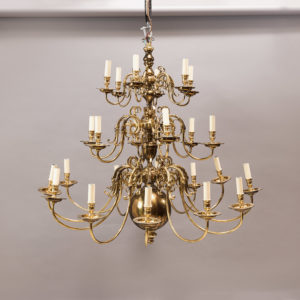
Large Dutch style brass chandelier,
£4,500Large Dutch style brass chandelier,
twenty-four light, the baluster stem with vase to the middle issuing three tiers of arms, PAT tested. 40kg. Two dents to the lowest sphere. A match to stock #s 79282 & 79283.£4,500 -
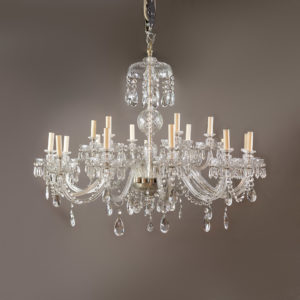
Eighteen branch cut glass chandelier,
£5,000Eighteen branch cut glass chandelier,
having an inverted cut glass dish decorated with glass teardrops, leading to decorative stem section consisting of shaped balusters and blown spheres engineered with criss-cross motifs above large decorative bowl containing two tiers of cut glass branches, each branch having drip pans with further glass teardrops, festoons of faceted glass decoration suspended between larger lower tier branches, further teardrop decoration to bowl, terminating with cut glass drop.£5,000 -
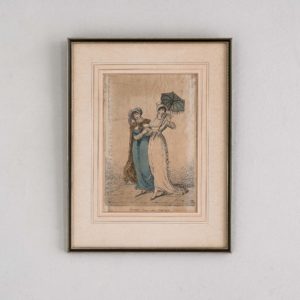
Seven Shilling Pieces
£200Seven Shilling Pieces
A hand coloured Georgian satire on the cost of female companionship at the Covent Garden Opera. Two courtesans fashionably dressed in the style of the period are shown arm-in-arm, walking along a pavement. One (right) holds up an open sunshade and a card inscribed ‘Miss Oldprice Covent Garden’.£200 -
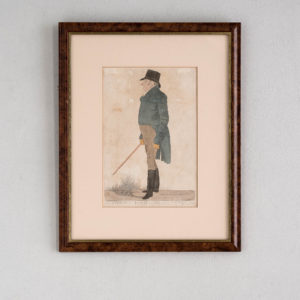
A View from the Old South Sea House
£370A View from the Old South Sea House
A hand-coloured etching by the Regency satirist Richard Dighton showing the brewer James Curtis. Richard Dighton was the son and apprentice of another noted caricaturist Robert Dighton and brother of the battle-scene painter Denis Dighton. The works of Robert and Richard Dighton are regarded as predecessors of the Vanity Fair style of the late nineteenth century. The series of portraits of City and West End characters to which this etching belongs was started in 1817 and Dighton would go on to publish a number of etchings during the next decade before retiring early to Cheltenham. This edition, of 1824, was printed by Thomas McLean Printseller & Publisher at 26 Haymarket, on the eastern side just north of Panton Street. The subject of the print, James Curtis, was a prominent and prosperous London brewer of the early 19th Century and his portrait, painted by Thomas Lawrence, now hangs in the Manchester Art Gallery. The Old South Sea House mentioned was located on the Threadneedle Street corner of Bishopsgate. The back of it apparently burned down in 1826 and was subsequently rebuilt. The building was the headquarters of the South Sea Company. Incorporated in 1711, the company was assigned a monopoly on British trade with Spanish America but, when that failed, it embarked upon a speculative scheme that ended in the economic collapse known as the ‘South Sea Bubble’ which saw many investors ruined. The building was partly remodeled in the 1850s and was eventually demolished at the end of the 19th century£370 -
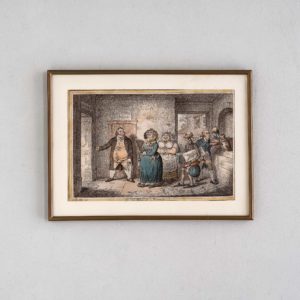
Old Maid on a Journey,
£450Old Maid on a Journey,
An original framed hand-coloured etching and engraving by caricaturist James Gillray. The corpulent figure of the independent polymath, antiquarian and collector Miss Sarah Sophia Banks is depicted being shown into the best bedroom of an Inn followed by a grotesque retinue of gurning servants carrying her assorted baggage. Miss Banks was a prolific collector of printed emphemera including broadsheets, newspaper clippings, visiting cards, caricatures, advertisements and playbills as well as being a leading numismatist of her day. Her great library of volumes on ancient coins as well as her capacious collection of the coins themselves was gifted to the nation upon her death and are now spread over the Royal Mint, The British Library and British Museum. One of the 18th Century’s brilliant but unacknowledged women, Sarah Banks was the sister of the famous botanist Joseph Banks who sailed with Captain Cook to New South Wales. According to recent scholarship as well as editing her brother’s manuscripts she often conversed with him on their subjects and many of her ideas were incorporated into his writings. Perhaps puzzlingly, given the warm and close friendship which was said to exist between Gillray and his wealthy female patron, Miss Banks is depicted as a obscenely fat and ugly. One can only speculate on the nature of the comedy and manners of the time (not to mention the sense of humour of the subject) when interpreting the comic effect of this print.£450 -
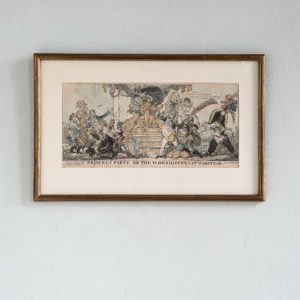
Princely Piety, or the worshippers at Wanstead,
£595Princely Piety, or the worshippers at Wanstead,
A hand-coloured etching by the caricaturist George Cruikshank depicting the wooing of a wealthy young heiress by a cast of reprobate suitors. Upon the death of her only brother James at the age of 11 in 1805 Catherine Tylney-Long became the richest commoner in England in her own right. At the tender of of 16 the ‘Wiltshire Heiress’ had come into a fortune of nearly £30,000,000 in today’s money. This made the poor girl a prime target for every fortune hunter and indebted rake in England who wished to clear his creditors. The law as it stood in the early 19th Century had degenerated to such a degree that, under the principle of coverture, it denied a married woman any property at all in her own right while her legal existence as a feme covert was entirely subsumed in that of her husband. This left the wealthy orphan daughter of Sir James Tylney long, 7th Baronet in a difficult and precarious position, caught between the social stigma attached to unmarried womanhood and the appeals of a host of insinuating cads seeking her hand in marriage. Here Cruikshank depicts the many and assorted indigent suitors for the hand of the wealthy heiress. To the left of the dais are shown Lord Kilworth and William Wesley-Pole, later 4th Earl of Mornington a dissipated Anglo-Irish nobleman, who dueled over the courtship of Catherine. Kneeling at the foot of the steps we may also see the figure of Romeo Coates, unintentionally comic actor and ‘improver’ of Shakespeare included apparently ‘not because of his pretensions, but his boasts and wishes’. Above him we see the fop and jobbing playwright, Sir Lumley Skeffington laying his poetic efforts at the feet of the heiress. On the right hand we see The Duke of Clarence, later William IV who by this point had debts of many hundreds of thousands of pounds holding back Baron-de-Geramb, a Spanish military adventurer and suspected Napoleonic spy who later became a Trappist monk where he used his position as procurator-general of that ancient order to defray his personal expenses. Above the Duke we see reproving the figure of Mrs Jordan, his ‘common-law’ wife with whom he had fathered many children at his retreat of Bushey Park. The farcical presentation of the situation belies it’s tragic outcome. Perhaps cajoled by just such unkind insinuations as are repeated in this caricature Catherine would choose the worst-of-the-bunch, William Wesley-Pole, as her preferred suitor. William Wesley-Pole-Tylney-Long, as he became by Royal Licence in 1812, was an unredeemed rake and not only abused and impoverished his saintly young wife but also passed her a debilitating infection and caused her family seat at Wanstead House to be demolished and sold for salvage. After a short and unhappy marriage Catherine died at the age of only 35 after receiving a final brutal letter from her estranged husband, the contents of which apparently caused her to have some form of seizure. Frustrated in his efforts to gain custody of their son William, on whom the family fortune had devolved, William Pole Tylney-Long-Wellesley, 4th Earl of Mornington (the final name by which he was known) died in 1857 unwept, unhonoured and unsung if also unrepentant. His obituary in the Morning Star described him as “A spendthrift, a profligate, and a gambler in his youth, he became debauched in his manhood… redeemed by no single virtue, adorned by no single grace, his life gone out even without a flicker of repentance”.£595 -
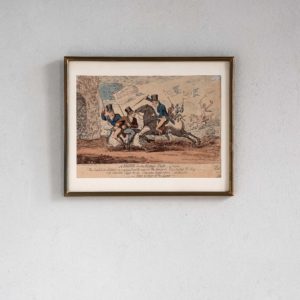
A Match for the King’s Plate,
£180A Match for the King’s Plate,
A hand coloured etching by George Cruikshank commenting on the contest for seat of Westminster. George Lamb and John Cam Hobhouse, 1st Baron Broughton are shown astride a lamb, Sir Francis Burdett, 5th Baronet, on a fine but injured charger and Henry ‘Orator’ Hunt straggles behind on an old carthorse representing the ‘Father of Reform’ Major John Cartwright. All five figures are shown racing for the winning post at the gate of His Majesty’s Treasury with an implication that the contest is for one for both power and political patronage while the twin devils or radical reform and universal suffrage inadvertently ‘steal a ride’ on the Baronet’s charger. The election of 1818 was the first to be staged after the end of the Napoleonic wars and was to become both a distillation of the latent class-conflicts bubbling over in the United Kingdom, and a fore-warning of the growth of militant radicalism that was to envenom and fracture British politics in the early parts of the 19th Century. Sir Francis Burdett was the Radical incumbent in Westminster and yet was firmly set against the new Radicalism which was beginning to colour the politics of the manufacturing districts of the North. This extreme and confident movement for universal manhood suffrage and political reform was by now associated with Henry Hunt, Major Cartwright and the writer and journalist William Cobbett. Caught in a cleft stick by his need both to mollify the prosperous and respectable Westminster electorate and yet maintain his own character as a tribune of the plebeians and Radical leader, Burdett was in a classic political double-bind. To the eye of the exiled Cobbett the Baronet was a placeman and an establishment ‘traitor’ but to his Tory opponents and the wavering freeholders and burgesses of Westminster he was beginning to appear a dangerous extremist. The suicide of Sir Samuel Romilly, the second member for Westminster, in November 1818 threw the situation wide open and the resulting by-election became something of a national sensation.£180 -
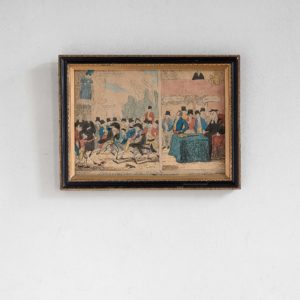
Persecution of the Saints.
£220Persecution of the Saints.
An original hand coloured etching by George Cruikshank.On 6 June 1820, Queen Caroline, estranged wife of George IV, returned from her exile on the continent, claiming her right to be crowned as Queen. The perceived harsh treatment of the Queen by the King and his Tory supporters caused her to become a figurehead for the political unrest that had been made worse by the Peterloo Massacre of 16 August 1819.In a desperate effort to rid himself of this turbulent wife George the IV ventured to have Caroline found guilty of adultery – the only legal justification for divorce at the time. All the while the King had preempitvely caused Caroline’s name to be omitted from the Prayer for the Royal Family in churches throughout England.With tensions rising and both sides digging in over the contest the cause of Queen Caroline began to assume for the parties involved a symbolic and totemic significance. Queen Caroline, to the Whigs and Radicals represented injured honesty and probity in public life while her exclusion from the coronation and regal honours stood for the debasement of the constitution and the irregular, arbitrary and incompetent tyranny of the Tory loyalists. The situation was becoming so febrile that many feared political and factional violence was inevitable.Into this contest stepped William Wilberforce, the great independent MP and abolitionist campaigner. The small informal group of evangelical Christians who surrounded him in Parliament were known, perhaps mockingly, as The Saints. Wilberforce thought that by the force of his own unimpeachable integrity he could persuade Caroline to abdicate some of her rights as the Royal consort and thereby forestall what had begun to look like a revolutionary confrontation.Wilberforce attended at the Queen’s residence on Portman Street in West London and presented a Motion for an Address to the Queen. He had been encouraged by Lord Brougham to believe that the Queen would accept the omission of her name from the public prayers. The Queen, standing in her rights and her honesty, flatly refused. Meanwhile the Radical London mob appears to have cajolled and roughed-up the sanctimonious delegation as they fled for their safety back to the House of Commons.As a result of the failure of Wilberforce’s attempts at mediation led to the trial of Queen Caroline and subsequent exclusion from the coronation ceremony.£220 -
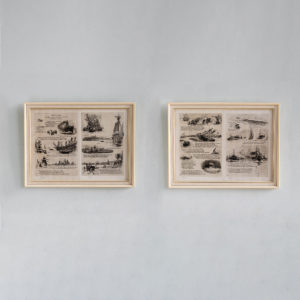
Our Fathers, To The Memory of the Nameless Killed and Wounded
£725 the pairOur Fathers, To The Memory of the Nameless Killed and Wounded
A set of four etchings in two frames depicting ships of war and life at sea in English history By William Wylie and accompanied by the words of Cpt. Ronald Hopwood’s poem Our Fathers. William Lionel Wylie was the most distinguished marine artist of the late nineteenth and early twentieth centuries. He became almost a painter laureate to the Royal Navy, so much so that during his funeral, in a scene reminiscent of Nelson’s state funeral in 1806, his body was rowed up Portsmouth Harbour in a naval cutter past battleships with dipped colours and bugles calling and quaysides lined with dockyard workers. Similarly Captain Ronald A Hopwood was described as the poet laureate of the Royal Navy by Time Magazine in 1941. His most enduring work, The Laws of the Navy, became and remains a sort of Works and Days primer for naval life, both inspiring and edifying seamen in the ways of the senior service. After the Battle of Jutland in 1916 when the press was critical of an apparent failure by the Royal Navy to achieve a clear victory against the Imperial German Navy the Times of London published The Old Ways, a poem by Hopwood and within this was a further poem, Our Fathers which was first written during the naval manoeuvres of 1913. Wyllie, we are told, was much taken with the verses and he arranged to illustrate them with the agreement of their author as a memorial of sorts to the dead (and perhaps as an apologia for the living) of the Battle of Jutland. The seaplane depicted appears to be a short type 184 used at Gallipoli where it became the first aircraft in the world to attack an enemy ship with an air-launched torpedo. The Battleship in the next image is of the King George V class and likely to be based on HMS Audacious, which Wylie had studied previously. The poem and illustrative etchings then go back in time to the navy of Elizabeth I’s time. The sailing ships depicted are galleons of the type which chased the Spanish Armada out of the channel, a scene depicted at the bottom of the first print. The second framed picture depicts naval exercises and gunnery practice, with a galleon being scraped and caulked by hand on a secluded beach in the Spanish Main. It concludes with a scene of high-technology Super-Dreadnoughts of the Queen Elizabeth class – a naval nominative choice which perhaps inspires the scheme of the whole work of reflection.£725 the pair -
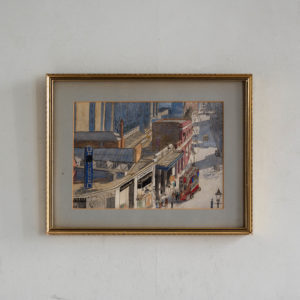
Watercolour of South Kensington Station
£650Watercolour of South Kensington Station
Framed watercolour of South Kensington underground station, painted in the mid 1920’s. Captured from a window of No.1 Old Brompton Road, the viewer is shown the view looking east over the station roof and down Pelham Street towards Brompton Cross. The scene shows a winter’s day with passengers climbing aboard the upper deck of K-Type Omnibus.£650 -
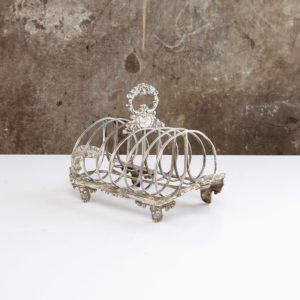
Rare William IV solid sterling silver toast rack,
£750Rare William IV solid sterling silver toast rack,
six sections, hallmarked John William Edward and Edwards Senior. 357.2 grams.£750 -
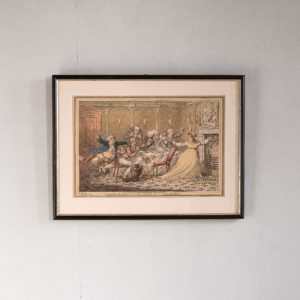
Company shocked at a lady getting up to ring the bell,
£360Company shocked at a lady getting up to ring the bell,
A hand-coloured satirical etching by James Gillray, Published by Hannah Humphrey. Five men are depicted courting a wealthy widow in her luxuriously furnished breakfast parlour over boiled eggs bread and muffins. The widow has risen from her chair to pull a bell-pull while frantic efforts of the suitors to stop her have produced a sequence of disasters. Published by Gillray’s long-time and eventual exclusive publisher, Hannah Humphrey. Mrs Humphrey was the sister of engraver William Humphrey and became not only an independent businesswoman in Georgian London but London’s leading seller of caricature prints. She began publishing prints in the 1770s at a premises on St Martin’s Lane before moving, first to Old Bond Street, then New Bond Street before finally settling at 27 St James’s Street. James Gillray lodged with Mrs Humphrey for twenty tears from 1791 and although some suspected an illicit relationship it was in all probability a commercial and platonic friendship. Mrs Humphrey cared for Gillray as his sight failed him and later tended to him during the alcohol induced madness of his last five years of life.£360
